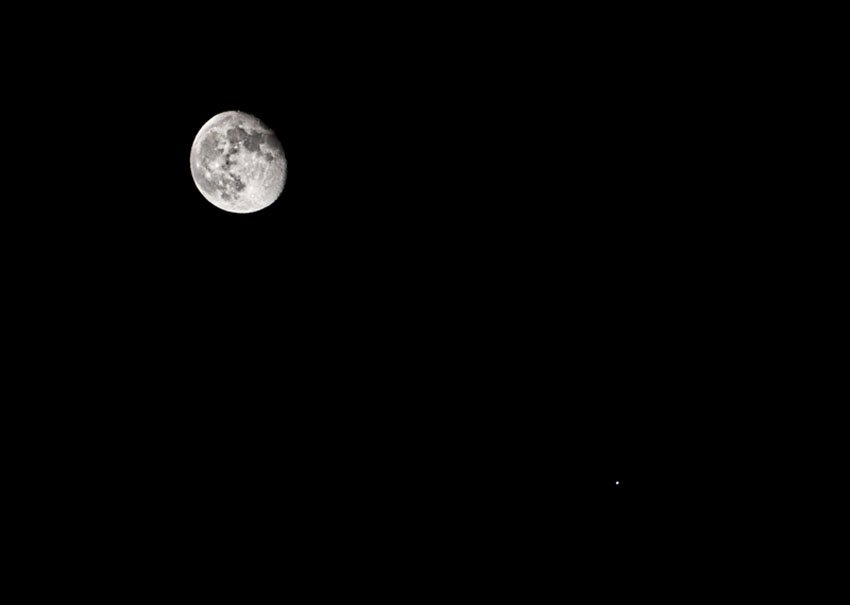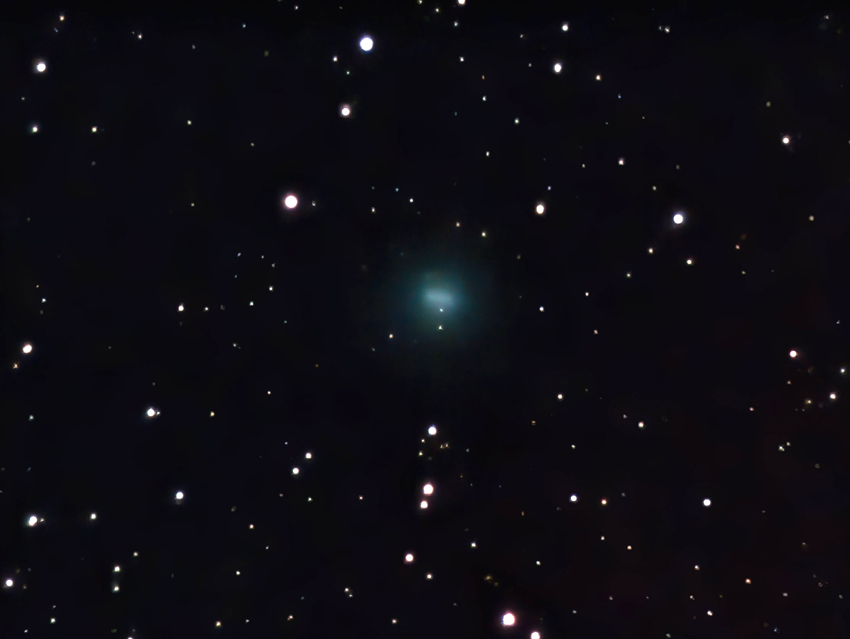Observing Reports
By Michael Amato
Because Comet Nishimura was so close to the Sun, I was not able to observe it directly. To view the comet, I had to observe it with the Stereo-A spacecraft which is observing the Sun. I watched it over two days around September 26. As the comet was passing the Sun, it suddenly brightened so I could see it easily. The comet’s tail was very bright but as a plasma wave from the Sun hit the comet head on it snapped the comet’s tail in two. That was quite a sight! I read later the tail reformed and the comet went on its merry way. I always look at the solar spacecraft instruments whenever a comet passes too close to the Sun for a person to see it. It was quite a comet to see.
While my brother Anthony and I were enjoying the October 1 conjunction of the Moon and Jupiter, he was able to take this image. Jupiter is at the lower right. It was a nice sight for us.

On October 8, with the Pleiades and the Mirfak Association out at the same moment, I decided to observe both with my 10X50 binoculars to see which one appealed to me more. For about 15 minutes, I went back and forth observing them. With the Mirfak Association, the stars were spread out over about two binocular fields and I must say it looked really impressive to me, but the Pleiades with their more bluish stars impressed me more. Also, because the sky was so pristine tonight, I was able to see a lot of fainter stars within the cluster. I also wanted to include the Hyades in this comparison, but alas, the clouds paid a visit. The next morning, October 9, I awoke at 4:45 am to view Orion under the once again pristine skies with my 5.1″ Short Tube Newtonian Rich Field Scope. The belt stars were surrounded by the Melotte cluster and because the skies were so good, I was able to see many more stars than I usually do. The areas above and below the Orion Nebula both had an impressive cluster of stars. The Orion Nebula also showed better than usual. I then turned my attention to Betelgeuse and it looked much dimmer than Rigel. This surprised me because I just read Betelgeuse is very bright again. Not true. A half hour later, I viewed Venus and Regulus together, separated by less than two degrees. Finally, I also viewed the Sun with my Sun Spotter Solar Scope yesterday afternoon. There was a arcing group on sunspots that were getting ready to rotate of the Sun’s face. What a nice two days of observing that was!
Astronomy in the dark skies of Maine
From Sunday October15 until Thursday October19 my brother Anthony, our friend Joe and I were up in Palermo, Maine to stay at Joe’s daughter Kim’s Air B&B. It was cloudy and rainy most of the time but on Tuesday, October 17 and Wednesday, October 18 the skies cleared out perfectly for a total of 90 minutes. Five of us including Kim’s partner Jordan shared my 10X50 and my brother’s 8X40 binoculars. The Milky Way jumped out at us and we first admired the summer Milky Way with just our naked eyes. We then scanned our galaxy with our two binoculars where we first landed on Cygnus directly over our heads. The stars in Cygnus overwhelmed us in the binoculars. We scanned Cassiopeia too with the same results. The rift was also seen easily, and that was something I haven’t seen in many years. The Pleiades in binoculars showed many faint stars in the cluster. That was a great sight. We observed M31, the Andromeda Galaxy, with our naked eyes and then when we viewed it with our binoculars. The galaxy covered the whole field of view and it actually looked like the Andromeda Galaxy. For me, the highlight of the trip was seeing the Perseus Double Cluster in binoculars. I couldn’t stop looking at it. It was simply breathtaking! Not to be outdone, the Mirfak Association was spectacular in binoculars. Finally, we viewed towards our east where we observed the winter Milky Way. While not as impressive as the summer Milky Way, it definitely was worth a look, especially with our binoculars. What a trip this was!
Comet Lemmon
On the evening of Thursday, November 2, my brother and I were able to observe 8th magnitude Comet Lemmon in the western sky through our 5″ MAK. This is our new Unistellar 5″ scope which automatically takes images while you are viewing. It works very well in light pollution which is why the comet looked so good. As the photo taken by Anthony shows, it was a fuzzy green blob. At the time, the comet was at its brightest and will now begin to fade as it leaves our neighborhood until the next time it comes around. Looking to next year, we will be visited by two bright comets in June and October. I am really looking forward to this.

Before dawn on Thursday morning, November 30, I along with one of my astronomy Facebook friends from another state got up before dawn to see if Venus’s phase would be at exactly half or Dichotomy as we were hoping it would. I observed Venus with my Short Tube 5.1″ Newtonian Scope. To both of us, it looked like we hit the jackpot as Venus did look like it was exactly half phase. It was my first time ever that I saw it at exactly half phase. We both agreed we had achieved Dichotomy of Venus. It was another astronomical first for me.
By Chris Predom
Below are images I took a minute before and about fifteen minutes after reappearance of pi Arietis, a 5.3 magnitude star on October 1 around 11 pm. This star is supposed to be a close double, but I did not see any steps in brightness as star reappeared from lunar limb. I did not time event as I was just doing some visual observing. I viewed Saturn, Jupiter and Pleiades (M45) that night. If I remember, the night was a little hazy, due to smoke in the upper atmosphere.

